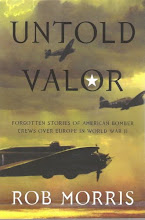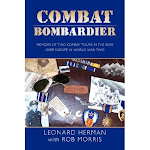Yesterday, I heard from a friend who works at a nursing home in Los Angeles named Brad. Brad has been keeping me posted on one of the residents at the home, a man by the name of Captain Halcott Thomas. Capt. Thomas flew with the 95th Bomb Group (H) in World War Two. That happens to be the Bomb Group about which I just finished writing a unit history.
Yesterday, Brad told me that Captain Thomas had put on his uniform and gotten his materials together to give a talk about his experiences and nobody showed up to listen to him. This was in part due to a scheduling error, but it also struck me as symptomatic of our society's flawed values. We are willing to pay a lot of money to watch grown men dribble balls and hit balls with sticks, and we follow every move of people like Paris Hilton and other 'celebrities'.
Now let me get this straight. We pay hundreds of millions to watch overpaid prima donnas but we aren't interested in seeing a real hero, one who helped assure our freedom sixty years ago at a time when the future of humanity literally hung in the balance. One Facebook comment that hit home came from Maria Eck Bullard, whose father, Harold Eck (still alive and in failing health) is a survivor of the U.S.S. Indianapolis sinking. Maria commented it was the saddest thing she'd heard in a long time. I agree.
A lot of people have expressed interest in contacting Capt. Thomas to thank him for his service. This warms my heart, and it will warm Capt. Thomas's even more. But there are thousands of men and women just like Captain Thomas all over the United States. For example, right here in Idaho Falls, there is a gentleman in the Alzheimers unit at a nursing home who is a former P-51 Mustang pilot with 3.5 aerial victories over Germany with the 339th Fighter Group. I visited him a bit last summer and then got busy and haven't been back lately. I dropped the ball.
I am pleased that the school where I work, Clair E. Gale Junior High, holds a Veteran's Day appreciation every year and invites as many local WWII vets as they can track down for a special lunch with the seventh grade students. The lady who coordinates this, Mrs. Pearson, also has the vets sitting at tables with kids who interview them. It is a fine time for all.
Last school year, my 9th grade students corresponded with three Bataan Death March survivors. We did it as a supplementary activity, outside the curriculum, because of the comments from so many Bataan Death March suvivors I'd been interviewing for my Untold Valor: Pacific book that nobody knew anything about the March and that it was never taught in the history books any more. To my surprise, at the end of the school year, many of my students said this was their favorite thing that they learned all year. Why? Because history came alive for them.
We need to recommit to honoring our WWII vets, because in another few years, they will all be gone. Call local nursing homes, or the local American Legion of VFW, and find out if there are vets in your area. In the past year, I have found right here in my small city, almost enough men to fill my Pacific book, including a Navy Cross-winning Okinawa Marine, another Marine who saw the flag go up on Iwo Jima, and many more.
Now, back to Captain Thomas.
Halcott Thomas was working on a degree in Engineering at the University of Southern California and was almost doen when Pearl Harbor was bombed December 7, 1941. "I decided to join the Army Air Corps," he told me in an interview July 2, 2010. "It took one and a half years in five different places to get to Dyersburg, Tennesse, where I got my whole crew.
"Most of the crew had never been in a B-17 Flying Fortress. This included my copilot. We spent a whole month at Dyersburg learning to take off and fly in a 36-plane formation, which is what we'd be using when we got to Europe. A lot of the other pilots didn't let their copilots fly much during this time, as the copilots had no experience. I took the opposite view. I let my copilot do three-fourths of the flying and then he was ready to roll."
After training, we flew to Goose Bay, Labrador. They showed us a movie taken from the nose of an aircraft that showed us how to locate the landing field in Greenland. We had to fly at low-altitude for seventy miles up a deep fjord. Eventually, we would see a three-masted schooner which had sunk in the middle of the fjord. There was a 12,000-foot mountain on the right side of the fjord. We were supposed to fly right between the masts and then we'd see the runway.
"Instructions were very clear. You land. You don't try to go around. And by the way, the runway is three hundred feet higher at the top than at the bottom. And while you're at it, look out for that 12,000 mountain.
"When we flew out of there, we took off, did a sharp turn, flew to the three-masted schooner and jumped out of the fjord. Our next stop was Ireland, and from there we went to England and were assigned to the 95th Bomb Group at Horham, England. I flew thirty missions with the 95th Bomb Group. I remember in particular one mission, my third, where we dropped guns and ammunition at low altitude to the Polish Underground. They were literally underground and the Germans were almost right on top of them. After dropping off the weapons, we flew on to Russia.
"This Russia mission had been planned for some time. Three times we went to briefings and were then told the mission was called off, because they had been unable to get Stalin to agree to let us land. It was a huge operation. All the materials and supplies we'd need when we landed in Russia had to be trucked in from the south before we arrived in a big convoy. Finally, we got clearance from Stalin and flew the mission." (After the war, a diplomat from the Polish Embassy tracked down Thomas and awarded him with a medal for helping to resupply the Polish Underground in its time of need).
Captain Thomas is doing a more extensive record for me, but this was from our conversation last night. It is an honor to thank this American hero.




















































